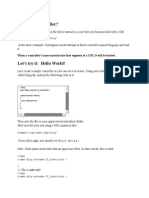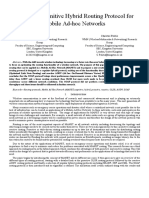0 ratings0% found this document useful (0 votes)
92 viewsHandy Mysql Commands Description Command
This document provides useful MySQL commands for logging in, creating and managing databases and tables, inserting and modifying data, joining tables, setting permissions, backing up and restoring data, and examples for creating tables. Key commands covered include selecting, inserting, updating, and deleting data; creating, dropping, and describing databases and tables; loading data from files; and dumping databases or tables for backup. Common tasks like filtering results, sorting data, and counting rows are also demonstrated through example MySQL queries.
Uploaded by
Shanju AmathCopyright
© © All Rights Reserved
We take content rights seriously. If you suspect this is your content, claim it here.
Available Formats
Download as DOCX, PDF, TXT or read online on Scribd
0 ratings0% found this document useful (0 votes)
92 viewsHandy Mysql Commands Description Command
This document provides useful MySQL commands for logging in, creating and managing databases and tables, inserting and modifying data, joining tables, setting permissions, backing up and restoring data, and examples for creating tables. Key commands covered include selecting, inserting, updating, and deleting data; creating, dropping, and describing databases and tables; loading data from files; and dumping databases or tables for backup. Common tasks like filtering results, sorting data, and counting rows are also demonstrated through example MySQL queries.
Uploaded by
Shanju AmathCopyright
© © All Rights Reserved
We take content rights seriously. If you suspect this is your content, claim it here.
Available Formats
Download as DOCX, PDF, TXT or read online on Scribd
You are on page 1/ 3
_
| \/ |_ _/ | / _ \| |
| |\/| | | | \ \| | | | |
|| | | |_| | ) | |_| | |
|_| |_|\ , | / \ \_\ |
| /
Handy MySQL Commands
Description Command
To login (from unix shell) use
[mysql dir]/bin/mysql h hostname u root p
h only if needed.
Create a database on the sql
create database [databasename]
server.
List all databases on the sql
show databases
server.
Switch to a database. use [db name]
To see all the tables in the db. show tables
To see database's field
describe [table name]
formats.
To delete a db. drop database [database name]
To delete a table. drop table [table name]
Show all data in a table. SELECT * FROM [table name]
Returns the columns and
column information pertaining show columns from [table name]
to the designated table.
Show certain selected rows
SELECT * FROM [table name] WHERE [field name] = "whatever"
with the value "whatever".
Show all records containing
SELECT * FROM [table name] WHERE name = "Bob" AND phone_number =
the name "Bob" AND the
'3444444'
phone number '3444444'.
Show all records not
containing the name "Bob"
SELECT * FROM [table name] WHERE name != "Bob" AND phone_number =
AND the phone number
'3444444' order by phone_number
'3444444' order by the
phone_number field.
Show all records starting with
SELECT * FROM [table name] WHERE name like "Bob%" AND phone_number =
the letters 'bob' AND the
'3444444'
phone number '3444444'.
Use a regular expression to
find records. Use "REGEXP
BINARY" to force case SELECT * FROM [table name] WHERE rec RLIKE "^a$"
sensitivity. This finds any
record beginning with a.
Show unique records. SELECT DISTINCT [column name] FROM [table name]
Show selected records sorted
in an ascending (asc) or SELECT [col1],[col2] FROM [table name] ORDER BY [col2] DESC
descending (desc).
Count rows. SELECT COUNT(*) FROM [table name]
select lookup.illustrationid, lookup.personid,person.birthday from lookup
Join tables on common
left join person on lookup.personid=person.personid=statement to join birthday in
columns.
person table with primary illustration id
Switch to the mysql db. INSERT INTO [table name] (Host,User,Password)
Create a new user. VALUES('%','user',PASSWORD('password'))
Change a users password.
[mysql dir]/bin/mysqladmin u root h hostname.blah.org p password 'newpassword'
(from unix shell).
Change a users password.
SET PASSWORD FOR 'user'@'hostname' = PASSWORD('passwordhere')
(from MySQL prompt).
INSERT INTO [table name]
Switch to mysql db.Give user
(Host,Db,User,Select_priv,Insert_priv,Update_priv,Delete_priv,Create_priv,Drop_priv)
privilages for a db.
VALUES ('%','db','user','Y','Y','Y','Y','Y','N')
To update info already in a UPDATE [table name] SET Select_priv = 'Y',Insert_priv = 'Y',Update_priv = 'Y'
table. where [field name] = 'user'
Delete a row(s) from a table. DELETE from [table name] where [field name] = 'whatever'
Update database
FLUSH PRIVILEGES
permissions/privilages.
Delete a column. alter table [table name] drop column [column name]
Add a new column to db. alter table [table name] add column [new column name] varchar (20)
Change column name. alter table [table name] change [old column name] [new column name] varchar (50)
Make a unique column so you
alter table [table name] add unique ([column name])
get no dupes.
Make a column bigger. alter table [table name] modify [column name] VARCHAR(3)
Delete unique from table. alter table [table name] drop index [colmn name]
LOAD DATA INFILE '/tmp/filename.csv' replace INTO TABLE [table name]
Load a CSV file into a table.
FIELDS TERMINATED BY ',' LINES TERMINATED BY '\n' (field1,field2,field3)
Dump all databases for
backup. Backup file is sql [mysql dir]/bin/mysqldump u root ppassword opt >/tmp/alldatabases.sql
commands to recreate all db's.
Dump one database for [mysql dir]/bin/mysqldump u username ppassword databases databasename
backup. >/tmp/databasename.sql
[mysql dir]/bin/mysqldump c u username ppassword databasename tablename >
Dump a table from a database.
/tmp/databasename.tablename.sql
Restore database (or database
[mysql dir]/bin/mysql u username ppassword databasename < /tmp/databasename.sql
table) from backup.
CREATE TABLE [table name] (firstname VARCHAR(20), middleinitial
VARCHAR(3), lastname VARCHAR(35),suffix VARCHAR(3),
Create Table Example 1. officeid VARCHAR(10),userid VARCHAR(15),username VARCHAR(8),email
VARCHAR(35),phone VARCHAR(25), groups
VARCHAR(15),datestamp DATE,timestamp time,pgpemail VARCHAR(255))
create table [table name] (personid int(50) not null auto_increment primary
Create Table Example 2. key,firstname varchar(35),middlename varchar(50),lastname varchar(50) default
'bato')
You might also like
- TOGAF 9 Template - Applications Portfolio CatalogNo ratings yetTOGAF 9 Template - Applications Portfolio Catalog14 pages
- Data Privacy - 30 Ways To Love Yourself OnlineNo ratings yetData Privacy - 30 Ways To Love Yourself Online34 pages
- Handy Mysql Commands Description CommandNo ratings yetHandy Mysql Commands Description Command3 pages
- Handy Mysql Commands Description Command: Main Menu Blog AboutNo ratings yetHandy Mysql Commands Description Command: Main Menu Blog About2 pages
- Handy Mysql Commands Description Command: Main Menu Blog AboutNo ratings yetHandy Mysql Commands Description Command: Main Menu Blog About3 pages
- Handy Mysql Commands Description Command: Main Menu Blog AboutNo ratings yetHandy Mysql Commands Description Command: Main Menu Blog About1 page
- Commands Description Samples: Joshua B. Posawen IT 223No ratings yetCommands Description Samples: Joshua B. Posawen IT 2234 pages
- By Below Method If Password Is Pass and User Name Is Root # (Mysql Dir) /bin/mysql - H Hostname - U Root - P PassNo ratings yetBy Below Method If Password Is Pass and User Name Is Root # (Mysql Dir) /bin/mysql - H Hostname - U Root - P Pass11 pages
- Amisha Dalal PGT (Computer Science) SQL Practice: Here Here HereNo ratings yetAmisha Dalal PGT (Computer Science) SQL Practice: Here Here Here2 pages
- PHP and Mysql: John Ryan B. Lorca Instructor INo ratings yetPHP and Mysql: John Ryan B. Lorca Instructor I57 pages
- Mysql: Eecs 448 Software Engineering Lab Lab #10: Mysql Due TimeNo ratings yetMysql: Eecs 448 Software Engineering Lab Lab #10: Mysql Due Time9 pages
- Cosc 2206 Internet Tools: Mysql Database System Installation Overview SQL SummaryNo ratings yetCosc 2206 Internet Tools: Mysql Database System Installation Overview SQL Summary64 pages
- Business Functional Areas Functions Processes PDFNo ratings yetBusiness Functional Areas Functions Processes PDF4 pages
- 7 Best Remote Administration Tool For PC - Your Hacker100% (1)7 Best Remote Administration Tool For PC - Your Hacker6 pages
- Analisa Dan Perancangan Sistem Informasi Akademik Nilai Siswa Di SD Negeri 41 Pangkalpinang Renti Oktaria PutriNo ratings yetAnalisa Dan Perancangan Sistem Informasi Akademik Nilai Siswa Di SD Negeri 41 Pangkalpinang Renti Oktaria Putri15 pages
- LCSinActionWorkshop-Operate5 CrashDumpAnalysis V2No ratings yetLCSinActionWorkshop-Operate5 CrashDumpAnalysis V221 pages
- Subject: PRF192-PFC Workshop 08: ObjectivesNo ratings yetSubject: PRF192-PFC Workshop 08: Objectives8 pages
- The Open Group Architecture Framework TOGAF 2007 Edition Incorporating 8 1 1 Groupdownload100% (1)The Open Group Architecture Framework TOGAF 2007 Edition Incorporating 8 1 1 Groupdownload42 pages
- Test Automation Using Unified Functional Testing PreviewNo ratings yetTest Automation Using Unified Functional Testing Preview38 pages
- Curriculam Vitae Designation:SAP ABAP Developer Mobile No: 7095000112No ratings yetCurriculam Vitae Designation:SAP ABAP Developer Mobile No: 70950001124 pages
- C10 E Business and Enterprise Resource Planning System 1No ratings yetC10 E Business and Enterprise Resource Planning System 19 pages
- What Is Second Level User Authentication and How It Is Going To Add Security To Dbankonline Customer AccountNo ratings yetWhat Is Second Level User Authentication and How It Is Going To Add Security To Dbankonline Customer Account8 pages






























































































